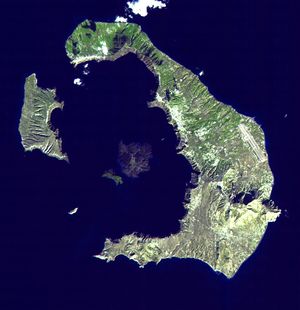17th century BC
| Millennium: | 2nd millennium BC |
|---|---|
| Centuries: | 18th century BC · 17th century BC · 16th century BC |
| Decades: | 1690s BC 1680s BC 1670s BC 1660s BC 1650s BC 1640s BC 1630s BC 1620s BC 1610s BC 1600s BC |
| Categories: | Births – Deaths Establishments – Disestablishments |
The 17th century BC is a century which lasted from 1700 BC to 1601 BC.
Contents |
Events

Satellite image of Thera, centre location of the Minoan eruption, one possible source of seventeenth century BC climatic disturbances
- c. 1700 BC: The last species of mammoth became extinct on Wrangel Island.
- c. 1700 BC: Indus Valley Civilization comes to an end but is continued by the Cemetery H culture
- 1700 BC: Belu-bani became the King of Assyria.
- c. 1700 BC: Minoan Old Palace period ends and Minoan Second Palace period starts in Ancient Greece.
- c. 1700 BC: beginning of the Late Minoan period on Crete.
- c. 1700 BC: Aegean metalworkers are producing decorative objects rivaling those of Ancient Near East jewelers, whose techniques they seem to borrow.
- c. 1700 BC: Lila-Ir-Tash started to rule the Elamite Empire.
- c. 1700 BC – Bronze Age starts in China.
- c. 1700 BC – Shang Dynasty starts in China.
- c. 1700 BC – 1450 BC: Young girl gathering saffron crocus flowers, detail of wall painting, Room 3 of House Xeste 3, Akrotiri (Santorini), Thera, is made. Second Palace period. It is now kept in Thera Foundation, Petros M. Nomikos, Greece.
- c. 1698 BC: Lila-Ir-Tash the ruler of the Elamite Empire died. Temti-Agun I started to rule the Elamite Empire.
- 1691 BC: Belu-bani, the King of Assyria died.
- c. 1690 BC: Temti-Agun I, the ruler of the Elamite Empire, died. Tan-Uli started to rule the Elamite Empire.
- 1690 BC: Libaia became the King of Assyria.
- c. 1680 BC: Egypt: Start of Sixteenth Dynasty.
- c. 1680 BC: Egypt: Development of leavened bread (date approximate).
- c. 1673 BC: Sharma-Adad I became the King of Assyria.
- c. 1661 BC: Iptar-Sin became the King of Assyria.
- c. 1655 BC: Tan-Uli, the ruler of the Elamite Empire, died.
- c. 1650 BC: Egypt: Start of the Seventeenth Dynasty.
- 1649 BC: Bazaia became the King of Assyria.
- c. 1674 BC: Egypt: Start of Fifteenth Dynasty.
- 1633 BC : Egypt: End of the Thirteenth Dynasty.
- 1627 BC: Beginning of a cooling of world climate lasting several years recorded in tree-rings all over the world.[1] It might have been caused by the Minoan eruption of Thera[2] or the Avellino eruption of Mount Vesuvius.[3]
- 1625 BC: Samsu-Ditana becomes King of Babylon (middle chronology).
- 1621 BC: Lullaia becomes the King of Assyria.
- 1620 BC: Mursili I becomes King of the Hittite Empire (middle chronology).
- 1615 BC: Shu-Ninua became the King of Assyria.
- 1601 BC: Sharma-Adad II became the King of Assyria.
- c. 1600 BC: Egypt: End of Fourteenth Dynasty.
- c. 1600 BC: The creation of one of the oldest surviving astronomical documents, a copy of which was found in the Babylonian library of Ashurbanipal: a 21-year record of the appearances of Venus (which the early Babylonians called Nindaranna): Venus tablet of Ammisaduqa.
- c. 1600 BC: The end of the Indus Valley civilization.
- c. 1600 BC: The overthrow of the ruling Amorite dynasty in Aleppo, Syria.
- c. 1600 BC: The date of the earliest discovered rubber balls.
- c. 1600 BC: Egypt conquered by Asian tribes known as the Hyksos—see History of ancient Israel and Judah.
- c. 1600 BC: Early Mycenaen culture: weapons, Cyclopaean walls and chariots.
- c. 1600 BC: Jie of Xia is overthrown by Tang of Shang in the Battle of Mingtiao
- Unetice culture
- Development of leavened bread in Egypt.
- Development of the windmill in Persia.
Significant persons
- Jie, The last ruler of Xia Dynasty, ruled China for 52 years until 1600 BC according to the Xia Shang Zhou Chronology Project.
Deaths
- 1695 BC—Sarah, wife of Abraham, according to the Hebrew Calendar
- 1686 BC—Hammurabi (short chronology)
- 1684 BC—Heremon, Irish legend
- 1677 BC—Terah, father of Abraham, according to the Hebrew Calendar
- 1664 BC—Arpachshad, son of Shem, son of Noah, according to the Hebrew Calendar
- 1637 BC—Abraham according to Jewish calculations. (2,123 years after biblical creation)
- 1634 BC—Salah, son of Arpachshad, according to the Hebrew Calendar
- 1602 BC—Shem, son of Noah, according to the Hebrew Calendar
Decades and years
|
||||||||||||||||||||||||||||||||||||||||||||||||||||||||||||||||||||||||||||||||||||||||||||||||||||||||||||||||||||||||||||||
References
- ↑ LaMarche, Valmore C. Jr. & Hirschboeck, Katherine K. (1984). "Frost rings in trees as records of major volcanic eruptions". Nature 307: 121–126. doi:10.1038/307121a0.
- ↑ Baillie, M. G. L. & Munro, M. A. R. (1988). "Irish tree rings, Santorini and volcanic dust veils". Nature 332: 344–346. doi:10.1038/332344a0.
- ↑ Vogel, J. S. et al. (1990). "Vesuvius/Avellino, one possible source of seventeenth century BC climatic disturbances". Nature 344: 534–537. doi:10.1038/344534a0.